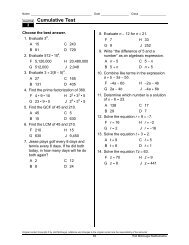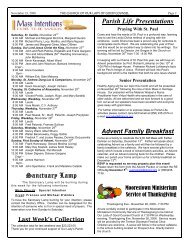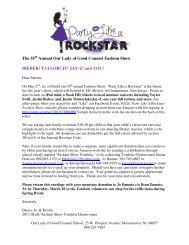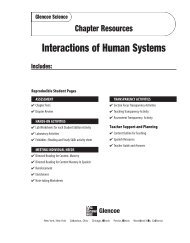Chapter 13 Resource: Circulation and Immunity
Chapter 13 Resource: Circulation and Immunity
Chapter 13 Resource: Circulation and Immunity
You also want an ePaper? Increase the reach of your titles
YUMPU automatically turns print PDFs into web optimized ePapers that Google loves.
Name Date ClassNote-taking Worksheet (continued)2. ___________ immunity—results when antibodies produced in another animal are introducedinto the body. Passive immunity does not ___________ as active immunity.Section 4DiseasesA. Scientists did not underst<strong>and</strong> how ___________ diseases were transmitted until the late 1800s<strong>and</strong> early 1900s.1. Louis Pasteur developed the ___________ process, which kills some bacteria in liquids.Meeting Individual Needs2. Robert Koch developed a method to ___________ <strong>and</strong> ___________ one type of bacteriumat a time.3. Joseph Lister learned to reduce surgery deaths by keeping his h<strong>and</strong>s <strong>and</strong> instruments___________.B. An ___________ disease is caused by a virus, bacterium, protist, or fungus <strong>and</strong> is spread froman infected organism or the environment to another organism.1. Diseases can be carried by ___________ such as rats, birds, cats, dogs, mosquitoes, fleas,<strong>and</strong> flies.2. ___________ can also be disease carriers.C. ___________ diseases (STDs) are infectious diseases spread during sexual contact.1. ___________ STDs include gonorrhea <strong>and</strong> syphilis.2. ___________ STDs include genital herpes <strong>and</strong> HIV (Human Immunodeficiency Virus).a. HIV infection can lead to ___________ (Acquired Immune Deficiency Syndrome)which attacks the immune system, causing the infected person to die of another disease.b. AIDS has no ___________, but several medicines are used to treat it.D. ___________ diseases are not spread from person to person; they may bechronic <strong>and</strong> long lasting.1. ___________ is a chronic disease associated with insulin production by the pancreas.a. ___________ diabetes results from too little or no production of insulin.b. ___________ diabetes results from improper insulin processing.2. ___________ results from uncontrolled cell growth <strong>and</strong> can occur anywhere in the body.a. Cancer can have many ___________ such as smoking, chemical exposure, radiationexposure, diet, or heredity.Copyright © Glencoe/McGraw-Hill, a division of the McGraw-Hill Companies, Inc.38 <strong>Circulation</strong> <strong>and</strong> <strong>Immunity</strong>
















